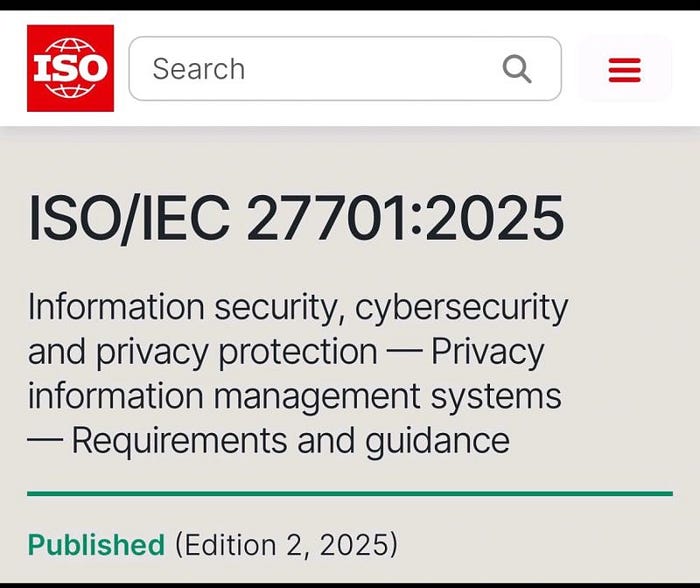ISO/IEC 27701:2025 Information security, cybersecurity and privacy protection — Privacy information management systems — Requirements and guidance
ISO/IEC 27701 is the international standard that defines requirements for a Privacy Information Management System (PIMS). The original 2019 version was published as an extension to ISO/IEC 27001 (Information Security Management System, ISMS) and ISO/IEC 27002, adding controls and concepts related to personal data (PII) and privacy.
In 2025, ISO released a revised edition. This update goes beyond minor editorial changes — it redefines the position of PIMS in the broader ecosystem of management systems.
Key Changes
1. PIMS as a Stand-Alone System
The most significant shift: PIMS can now be implemented independently of ISO 27001. Organizations are no longer required to maintain an ISMS as a prerequisite.
Pros: lowers the entry barrier for companies that manage personal data but do not yet have a full security management framework. Cons: risks of decoupling privacy from security, which runs counter to the "security + privacy by design" principle.
2. Alignment with the High-Level Structure (HLS)
The 2025 edition adopts ISO's High-Level Structure (HLS) — the same management system framework used in ISO 9001, 14001, and 27001 (2022). This harmonization simplifies integration across multiple standards by unifying key clauses on context, leadership, planning, evaluation, and improvement.
For organizations maintaining several certifications, this significantly streamlines audits and internal controls.
3. Updated Context and Terminology
The new edition includes expanded guidance on:
- processing in cloud and outsourced environments,
- cross-border data transfers,
- interactions with major privacy regulations (GDPR, CCPA, PDPA, etc.),
and evolving expectations of data subjects in digital ecosystems.
In short — ISO 27701:2025 brings privacy governance into line with today's decentralized, data-driven world.
Practical Significance
ISO 27701 provides a structured and auditable framework for managing personal data responsibly. It doesn't guarantee compliance with any single law, but it helps organizations:
- define clear roles of controllers and processors;
- formalize privacy policies and operational procedures;
- align information security controls with privacy principles;
- demonstrate adherence to GDPR fundamentals such as accountability, transparency, and data minimization.
Implementation Challenges
- Defining the PIMS Scope The scope must be clear and balanced — too broad makes it unmanageable, too narrow makes it meaningless.
- Synchronizing Security and Privacy Controls ISO 27001 focuses on technical and organizational security; ISO 27701 adds lawful and proportional data processing. Without coordination, privacy turns into paperwork, or security becomes blind to legality.
- Business Engagement PIMS cannot live solely within the IT or compliance department. HR, marketing, operations, and leadership must all participate — otherwise the system remains formal and ineffective.
- Certification vs. Self-Declaration The 2025 edition allows both accredited certification and internal self-declaration, depending on organizational needs and maturity.
Strategic Implications
ISO 27701:2025 marks a broader shift from "security compliance" toward "data governance." Organizations are expected not only to protect data, but also to manage it lawfully, transparently, and ethically.
In the coming years, we can expect:
- tighter integration of PIMS with ESG and AI governance (ethics, transparency, explainability);
- more scrutiny on cross-border data flows;
- wider adoption of ISO 27701 certification as a trust signal for partners, clients, and regulators.
Practical Steps
- Conduct a gap analysis between your current practices and ISO 27701:2025 requirements.
- Define roles and responsibilities — DPO, controller, processor.
- Implement PII inventory and data flow mapping.
- Update data subject notification and request-handling procedures.
- Link your PIMS to incident management and audit processes (ISO 27035, 27008).
- Establish a PDCA improvement cycle (Plan–Do–Check–Act).
